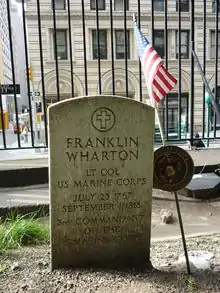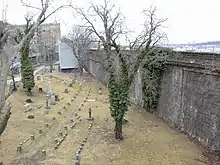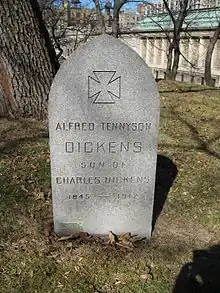Trinity Church Cemetery
Trinity Church Cemetery consists of three separate burial grounds associated with Trinity Church in New York City. The first was established in the original Churchyard, located since 1698 at 74 Trinity Place at Wall Street and Broadway. When St. Paul's Chapel (St. Paul's Chapel of Trinity Church) was built in 1766, roughly 440 yards (400 m) up Broadway, a burial place was added in its small churchyard. In 1842, Trinity Church was running out of space in its churchyard, so it established Trinity Church Cemetery and Mausoleum in Upper Manhattan; this parcel, located between Broadway and Riverside Drive, was bought from John James Audubon (a portion of the land he bought in 1841 for his own estate),[1] with the cemetery located beside the Chapel of the Intercession that Audubon co-founded in 1846.[2]
Church of the Intercession and Trinity Church Cemetery | |
 Trinity Church Cemetery at Broadway and Wall Street | |

| |
| Location | Trinity Church (shown): 74 Trinity Place Church of the Intercession: 550 West 155th Street St. Paul's Chapel: 209 Broadway New York, New York |
|---|---|
| Coordinates | 40°42′30″N 74°00′42″W |
| Built | 1697 |
| NRHP reference No. | 80002677 |
A no longer extant Trinity Church Cemetery was the Old Saint John's Burying Ground for St. John's Chapel. This location is bounded by Hudson, Leroy and Clarkson streets near Hudson Square. It was in use from 1806–52 with over 10,000 burials, mostly poor and young. In 1897, it was turned into St. John's Park, with most of the burials left in place. The park was later renamed Hudson Park, and is now James J. Walker Park.[3] (This park is different from a separate St. John's Park, a former private park and residential block approximately one mile to the south that now serves as part of the Holland Tunnel access.)
The burial grounds have been the final resting place for many historic figures since the Churchyard cemetery opened in 1697. A non-denominational cemetery, it is listed in the United States National Register of Historic Places and is the only remaining active cemetery in Manhattan.[2][4] There are two bronze plaques at the Church of the Intercession cemetery commemorating the Battle of Fort Washington, which included some of the fiercest fighting of the Revolutionary War.
Trinity Church Cemetery, along with Broadway, marks the center of the Heritage Rose District of New York City.[5]
Notable burials

Trinity Churchyard
- William Alexander, Lord Stirling (1726–1783), Continental Army Major General during the American Revolution
- John Alsop (1724–1794), Continental Congress delegate
- William Bayard Jr. (1761–1826), banker
- William Berczy (1744–1813), Canadian painter and pioneer buried in unmarked grave and name recorded as William Burksay
- William Bradford (1660–1752), colonial American printer
- Richard Churcher (1676–1681), a child whose grave is marked with the oldest carved gravestone in New York City
- Angelica Schuyler Church (1756–1814), daughter of Philip Schuyler, sister of Elizabeth Schuyler Hamilton
- Michael Cresap (1742–1775), frontiersman
- John R. Fellows (1832–1896), U.S. representative
- Robert Fulton (1765–1815), inventor
- Albert Gallatin (1761–1849), U.S. congressman, Secretary of the Treasury, founder of New York University
- Horatio Gates (1727–1806), Continental Army general during the American Revolution
- James Gordon (1735-1783), 80th Regiment of Foot (Royal Edinburgh Volunteers) Lieutenant Colonel
- Aaron Hackley, Jr. (1783–1868), U.S. representative
- Alexander Hamilton (1755/57–1804), American revolutionary patriot and Founding Father; first U.S. Secretary of the Treasury, and a signer of the United States Constitution
- Elizabeth Schuyler Hamilton (1757–1854), wife of Alexander Hamilton, co-founder and deputy director of New York's first private orphanage,[6] now Graham Windham
- Philip Hamilton (1782–1801), first son of Alexander Hamilton, grandson of U.S. General Philip Schuyler
- John Sloss Hobart (1738–1805), U.S. senator
- William Hogan (1792–1874), U.S. congressman
- James Lawrence (1781–1813), naval hero during the War of 1812
- Francis Lewis (1713–1802), signer of the Declaration of Independence
- Walter Livingston (1740–1797), delegate to the Continental Congress

- Luther Martin (1744–1826), delegate to the Continental Congress
- Charles McKnight (1750–1791), Continental Army surgeon
- John Jordan Morgan (1770–1849), U.S. representative
- Thomas Jackson Oakley (1783–1857), U.S. representative
- John Morin Scott (1730–1784), Continental Congress delegate, Revolutionary War general, first secretary of state of New York
- George Templeton Strong (1820–1875), diarist, abolitionist, lawyer
- Robert Swartwout (1779–1848), brigadier general, Quartermaster general of the War of 1812
- Silas Talbot (1750–1813), U.S. Navy commodore, second captain of the USS Constitution
- John Watts (1749–1836), U.S. representative
- Franklin Wharton (1767–1818), Commandant of the Marine Corps, 1804–1818
- Hugh Williamson (1735–1802), American politician, signer of the Constitution of the United States
- John Peter Zenger (1697–1746), newspaper publisher whose libel trial helped establish the right to a free press
In the northeast corner stands the Soldiers' Monument, with a plaque reading: "At a meeting of Citizens held at the City Hall of the City of New York June 8, 1852: It was resolved That the Erection of a becoming Monument with appropriate inscriptions by Trinity Church to the Memory of those great and good Men who died whilst in Captivity in the old Sugar House and were interred in Trinity Church Yard in this City will be an act gratifying not only to the attendants of this Meeting but to Every American Citizen."[7] The claim those prisoners are buried in Trinity Churchyard is disputed by Charles I. Bushnell, who argued in 1863 that Trinity Church would not have accepted them because it supported Great Britain.[8] Historian Edwin G. Burrows explains how the controversy related to a proposal to build a public street through the churchyard.[9]
Trinity Church Cemetery and Mausoleum



- Mercedes de Acosta (1893–1968), writer, socialite
- Rita de Acosta Lydig (1876–1929), socialite
- John Jacob Astor (1763–1848) business magnate, progenitor of the Astor family of New York
- John Jacob Astor III (1822–1890), financier and philanthropist
- John Jacob Astor IV (1864–1912), millionaire killed in the sinking of the Titanic
- John Jacob Astor VI (1912–1992), shipping magnate
- William Backhouse Astor, Sr. (1792–1875), real estate businessman
- William Backhouse Astor, Jr. (1829–1892), businessman and race horse breeder/owner
- John James Audubon (1785–1851), ornithologist and naturalist
- Estelle Bennett (1941–2009), member of the 1960s girl group The Ronettes
- John Romeyn Brodhead (1814–1873) Historian of early colonial New York
- John Winthrop Chanler (1826–1877), United States Congressman
- William Astor Chanler (1867–1934), United States Congressman
- Cadwallader D. Colden (1769-1834), Abolitionist New York Manumission Society (1806-1834); Mayor of New York City (1818-1821)
- William Augustus Darling (1817–1895), United States Congressman
- James De Lancey (1703–1760), Colonial Governor of New York
- Alfred D'Orsay Tennyson Dickens (1845–1912), lecturer on the life of his father, Charles Dickens
- John Adams Dix, (1798–1879) soldier, United States Senator, Secretary of the Treasury, Governor of New York, statesman
- Ralph Waldo Ellison, (1914–1994), author and educator
- Madeleine Talmage Force (1893–1940), socialite, Titanic survivor, second wife of John Jacob Astor IV
- Cuba Gooding Sr. (1944–2017), singer and actor
- Edward Haight (1817–1885), United States Congressman
- Abraham Oakey Hall (1826–1898), Mayor of New York City
- Eliza Jumel (1775–1865), second wife of Aaron Burr
- Dita Hopkins Kinney (1855—1921) first superintendent of United States Army Nurse Corps (1901-1909)
- Edward I. Koch (1924–2013), Mayor of New York City (1978-1989)[4]
- Robert O. Lowery (1916–2001) first African-American New York City Fire Commissioner (1966-1973)
- George Malloy (1920–2008) pianist, accompanied Camilla Williams singing "The Star-Spangled Banner", preceding Martin Luther King Jr. delivering his "I Have a Dream" speech, during the August 1963 March on Washington for Jobs and Freedom
- Robert Bowne Minturn (1805-1866) prominent New York merchant, philanthropist; shipper owner of Flying Cloud
- James Monroe (1799–1870), U.S. Congressman
- Clement Clarke Moore (1779–1863), clergyman, attributed author of Christmas poem A Visit from St. Nicholas
- Hercules Mulligan (1740-1825), spy during the American Revolution, friend of Alexander Hamilton.
- Jerry Orbach (1935–2004), actor[10]
- Caroline Webster Schermerhorn (1830–1908), socialite, doyenne of Gilded Age New York society
- Thomas Fielding Scott (1807–1867), first missionary Episcopal Bishop of Washington and Oregon
- Samuel Seabury (1873–1958), New York City Judge
- Fernando Wood (1812–1881), Mayor of New York City
.jpg.webp)
Churchyard of St. Paul's Chapel
- George Frederick Cooke (1756–1812), actor
- Richard Coote, 1st Earl of Bellomont (1636–1701), British colonial governor
- John Holt (1721–1784), publisher
- William Houstoun (1755–1813), Continental Congress delegate for whom Houston Street was named
- Richard Montgomery (1738–1775) Major General in the Continental Army during the American Revolution
- Stephen Rochefontaine (1755–1814), Continental Army officer during the American Revolution
References
- Jackson, Kenneth T.; Keller, Lisa; Flood, Nancy, eds. (December 1, 2010). The Encyclopedia of New York City (2nd ed.). Yale University Press. p. 76. ISBN 9780300114652. Retrieved September 7, 2020 – via Google Books.
- Julie Besonen (February 6, 2015). "Resting Place for the High and the Low: The Trinity Church Cemetery in Washington Heights Holds Plenty of History". New York Times.
- French, Mary (January 5, 2011). "St. John's Cemetery". Retrieved June 10, 2019.
- Mary Frances Schjonberg (February 4, 2013). "Former New York Mayor Ed Koch laid to rest in Trinity plot". Episcopal News Service.
- Scott Stringer - Manhattan Borough President Archived July 18, 2011, at the Wayback Machine. Mbpo.org. Retrieved on September 7, 2013.
- Chernow, Ron (March 29, 2005). "Epilogue". Alexander Hamilton. Penguin. ISBN 9781101200858.
- Chi, Sheena (December 15, 2008). "Trinity Church—Soldiers' Monument—Memorial for Unknown Revolutionary War Heroes". Archived from the original on December 16, 2019. Retrieved December 16, 2019. This inscription is on the south side. An inscription on the east side is more general: "Sacred to the memory of those brave and good Men who died whilst imprisoned in this City for their devotion to the cause of American independence." (Burrows, cited below, p. 230 (caption); photos at Find a Grave, cited below)
- Bushnell, Charles I. (1863). A Narrative of the Life and Adventures of Levi Hanford, a Soldier of the Revolution. New York: [privately printed]. pp. 66–70 (note 27). This note was also published separately as a pamphlet with its own title: Bushnell, Charles Ira (1863). The Claim of Trinity Church to Having Furnished Burial Places For Some of the American Prisoners, Who Died in the Old Sugar House Prison, in Liberty Street, During the Revolution, Examined and Refuted. New York: [privately published].
- Burrows, Edwin G. (2008). Forgotten Patriots. New York: Basic Books. pp. 228–30. ISBN 978-0-465-00835-3.
- Gilvey, John Anthony (May 1, 2011). Jerry Orbach: Prince of the City - His Way From The Fantastiks to Law & Order. Milwaukee, Wisc.: Applause Theatre & Cinema Books. p. 152. ISBN 978-1-42348-845-3.
External links
| Wikimedia Commons has media related to Trinity Church Cemetery. |
- At Find a Grave: Trinity Churchyard, Trinity Churchyard Soldier's Monument, Trinity Church Cemetery and Mausoleum, Saint Paul's Chapel and Churchyard
- Trinity Church Official Site.
- Hi-Res Photo Gallery of the Trinity Church Cemetery.
- Trinity Tombstone & Churchyard Gallery
- Trinity Church Cemetery and Mausoleum records at Trinity Wall Street Archives

